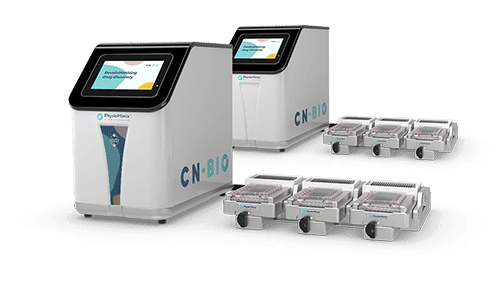Organoids are miniaturized, simplified versions of human organs that self-organize in in vitro culture within a 3D cellular matrix. They are generally cultured from primary human cells, or stem cells, to form tissues that better represent in vivo physiology and function than 2D cell cultures, but what do next-generation organoids look like?
Originally published in Drug Target Review, Issue 3, 2023.
Organoids can be grown from virtually any human or animal organ, and signify the next iteration in complexity versus spheroids. Whilst both generate 3D structures comprising multiple cell types, organoids offer greater complexity that, histologically and genetically, better resemble the original organ.
Researchers utilise organoids for a diverse range of applications, including disease modelling, drug discovery and development, personalized medicine, biological therapies and tissue engineering. They provide valuable preclinical insights into how treatments may affect diseased or healthy organs that can better inform clinical studies.
As with any model, however, organoids are not perfect. There are challenges and limitations that surround their use, including longevity, vascularization, immune-component inclusion, de-differentiation of cell types, culture variability and organoid homogeneity. With organoids holding promise in a diverse range of areas, despite being seemingly constrained by a long list of limitations, many researchers are now asking ‘how can these challenges be overcome?’.
One simple adjustment when using organoids is to switch to perfused cell culture, where a continuous flow of culture medium is applied to the organoids, mimicking blood flow. Perfusion serves many functions. As with blood, perfusion provides constant oxygen and nutrients whilst removing waste. This is particularly important for organoid growth and differentiation, as they often suffer from arrested growth and necrotic cores. The removal of this major limitation allows for larger tissues to be produced, which can enable more data-rich analysis.
In addition, perfusion provides vital mechanical cues. We live through mechanical forces and mechanical stresses – our heartbeat, movements, and muscle tension all provide critical and fundamental biomechanical cues. By introducing the shear stresses of the microcirculation into models, it better mimics human physiology and biochemistry. Another critically important aspect of perfusion is cell-to-cell communication. Perfusion induces intercellular movement of the secretome – such as cytokines, proteins and vesicles, thus recreating similar conditions to the human body.
Culturing organoids in perfused conditions using organ-on-a-chip technologies (OOC), alternatively known as microphysiological systems (MPS), can alleviate many of the aforementioned limitations. OOC technology plays a key role in overcoming the lack of longevity seen in organoids models. This finite longevity can restrict their application, particularly when investigating latent drug toxicity effects or long-term efficacy.
Tissues generated by OOC devices are three-dimensional tissues, with long-term maintenance of cell health and function for multiple weeks or months facilitated by perfusion. This is a notable increase on conventional organoid cultures, which often lose viability and function in only a few days or weeks (1,2). To further support perfusion, some liver-on-a-chip devices contain scaffolds with collagen-coated pores that encourage microtissue formation. The microtissues form by self-directed assembly from a pre-mix of primary cells and are relatively uniform. Forming within the pores, the microtissues leave an internal lumen through which media can flow, circumventing necrotic core issues and representing the hepatic sinusoid architecture. Because of this increased longevity, these models enable investigations into prolonged chronic exposure to drugs alongside long-term studies of more complex biological interactions (3).

Figure 1: Liver-on-a-chip tissue formed in a pore within a scaffold. Photo credit: Dr Emily Richardson, CN Bio.
Physiological relevance is another key obstacle that limits the applications of some organoids, particularly for barrier organs such as the lungs. Architecturally, the lung airway forms a pseudostratified epithelium in which the apical side is subject to the air during breathing. Organoids are commonly cultured submerged in media or gels to enable their formation, so despite apical-in or apical-out lung organoids being developed, they are not subject to the same cues as in vivo. Consequently, organoids have limited use for study areas including infection, environmental research, and drug development, as the main route of entry into the lung – aerosolization and inhalation – cannot occur. Furthermore, key pulmonary functional endpoints such as cilia beat frequency and mucus production cannot be fully understood. Utilising OOC, researchers can create more physiologically relevant barrier models, enabling simultaneous epithelial exposure to the air and media perfusion underneath (4).
The relatively large tissues that OOC can form are highly functional and deliver clinically relevant endpoints, toxicity output biomarkers, and human-relevant metabolism to allow data to be compared to in vivo or clinical scenarios (5). These have been notoriously difficult to detect in vitro, but larger-scale organ-on-a-chip microtissues increase assay sensitivity to the point where more sophisticated clinical chemistry outputs can be detected (e.g., aspartate transaminase (AST) and alanine transaminase (ALT)) and more subtle toxicities, such as Phase I and II metabolites, can also be identified (6). The larger cultures enable multiple assays to be run per OOC tissue for both soluble cell health and functional markers, as well as mining tissues for data-rich endpoints such as high-content imaging and -omics assays (7, 8).
Moreover, it is possible to add further human relevance to OOC by interlinking organ models. For example, connecting liver tissues with another “route of entry” organ (gut or lung) enables the study of reactive metabolite-driven toxicity as well as the evaluation of drug absorption and metabolism (9), and bioavailability (10). Tissue-resident or peripheral immune cells can also be incorporated into OOC with circulating media perfusion. The recapitulation of the immune system allows scientists to uncover immune-mediated toxicity issues, induce common disorders that have an inflammatory element, such as Non-Alcoholic Steatohepatitis (NASH) (5), or to model human responses to infection, such as pulmonary infections or Hepatitis B (2).
To conclude, organoids are a powerful in vitro tool that has enabled researchers to start bridging the gap between preclinical and clinical data. By paving the way forward, organoids have enabled the development of more complex cell cultures like OOC that accurately recapitulate key aspects of human physiology. Using these models, researchers can gain critical in vitro insights during drug development, to better inform in vivo predictions.

Figure 2. Bronchial lung MPS tissue after 7 days culture at ALI, with bronchial cells forming a pseudostratified epithelium on the apical side and endothelial cells on the basolateral side of the membrane, respectively. Tissue is stained with Alcian blue to highlight mucus production. Photo credit: Dr Emily Richardson, CN Bio.
For more information about CN Bio’s PhysioMimix OOC technology click here:
For more information about PhysioMimix applications click here
For more information about CB Bio’s Contract Research Services click here
References:
- Rubiano et al., Characterizing the reproducibility in using a liver microphysiological system for assaying drug toxicity, metabolism, and accumulation. Clin Transl Sci, 2021.
- Ortega-Prieto et al., 3D microfluidic liver cultures as a physiological preclinical tool for hepatitis B virus infection. Nat Commun, 2018.
- Long et al., Modeling therapeutic antibody small molecule drug-drug interactions using a three-dimensional perfusable liver coculture platform. Drug Metab Dispos, 2016.
- Phan et al., Advanced pathophysiology mimicking lung models for accelerated drug discovery, Biomat Res. 2023.
- Kostrzewski et al., A microphysiological system for studying nonalcoholic steatohepatitis. Hepatol Commun., 2019.
- Rowe et al., Perfused human hepatocyte microtissues identify reactive metabolite-forming and mitochondria-perturbing hepatotoxins. Tox In Vitro, 2018.
- Gallager et al., Normalization of organ-on-a-Chip samples for mass spectrometry based proteomics and metabolomics via Dansylation-based assay. Tox In Vitro, 2023.
- Novac et al., Human liver microphysiological system for assessing drug-induced liver toxicity in vitro. JoVE, 2022.
- Milani et al., Application of a gut-liver-on-a-chip device and mechanistic modelling to the quantitative in vitro pharmacokinetic study of mycophenolate mofetil. Lab Chip, 2022.
- Abbas et al., Improved prediction of oral bioavailability using a gut-liver microphysiological system. Application note, 2022.



